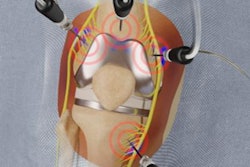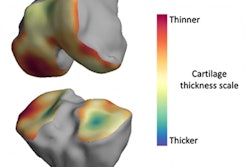
An artificial intelligence (AI) algorithm that analyzes 3D MR images in addition to clinical and demographic information can predict with a promising level of accuracy if patients will require a total knee replacement in the future, according to research published online April 14 in Scientific Reports.
A team of researchers led by Aniket Tolpadi of the University of California, San Francisco trained deep-learning algorithms based on knee radiographs as well as 3D MRI. They also assessed the impact of including clinical and demographic variables along with imaging as part of an integrated model.
In testing, the integrated model based on MRI was more sensitive than a similar integrated model that used x-ray images. This performance gap was particularly evident in patients with severe or no osteoarthritis (OA).
"By delivering such performance, this pipeline can identify patients at risk of [total knee replacement] with high sensitivity and specificity, and for patients with no or moderate OA, this can allow a noninvasive treatment to be implemented that prolongs good health of the knee and delays [total knee replacement]," the authors wrote.
The researchers trained a type of convolutional neural network called DenseNet-121 using a dataset from the Osteoarthritis Initiative (OAI) study, which included 4,796 patients with 2D posteroanterior radiographs and 3D sagittal double-echo steady-state (DESS). Of these, 65% were used for network training, 20% were used for validation, and 15% were set aside for testing.
| Performance of algorithm for predicting total knee replacement | ||
| Integrated x-ray model | Integrated MRI model | |
| Overall | 0.890 | 0.834 |
| Patients without OA | 0.799 | 0.943 |
| Patients with severe OA | 0.641 | 0.726 |
The integrated x-ray model may have had higher performance on the overall test set, but the integrated MRI model's results on patients with no OA and with severe OA showed that the MRI model had a better combination of sensitivity and specificity, according to the researchers.
"While [the] integrated x-ray pipeline delivers higher accuracy than [the] integrated MRI pipeline, [the] integrated MRI pipeline yields improved sensitivity over integrated x-ray pipeline across all stages of OA, markedly so at no OA," they wrote.
The researchers highlighted the integrated MRI model's performance in patients without OA -- the most difficult type of patient for predicting total knee replacement.
"This performance marks progress towards a model that identifies patients at risk for [total knee replacement] such that nonsurgical treatment strategies can be implemented to delay [total knee replacement]," the authors wrote.
The researchers also sought to identify MRI biomarkers for total knee replacement by comparing the model's analysis in control cases with that of total knee replacement patients. They found that the medial patellar retinaculum, gastrocnemius tendon, and plantaris muscle were associated with an increasing risk of total knee replacement when those areas were identified as hotspots by the model.
On the other hand, the model's assessment of several tissues within and near the tibiofemoral joint reflected a reduced risk of total knee replacement, according to the authors.



.fFmgij6Hin.png?auto=compress%2Cformat&fit=crop&h=100&q=70&w=100)





.fFmgij6Hin.png?auto=compress%2Cformat&fit=crop&h=167&q=70&w=250)











